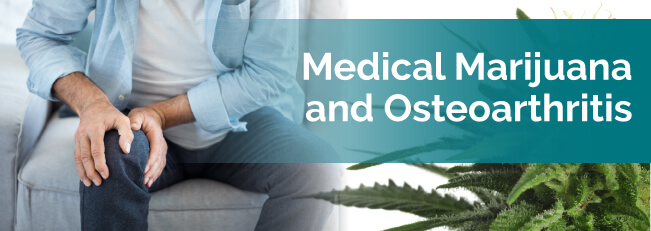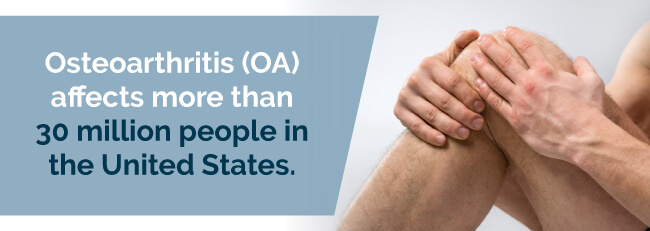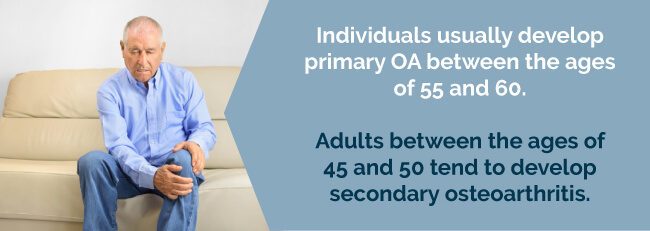
Osteoarthritis (OA) affects more than 30 million people in the United States. Arthritis is an incredibly frustrating condition to live with. Easy tasks like standing up, opening a jar or walking around the supermarket are unbearable due to chronic pain. Only a few treatments have offered arthritis sufferers effective relief, leaving them to turn to anti-inflammatory medications, potentially-addictive painkillers and even invasive surgery.

However, many osteoarthritis sufferers are now turning to medical marijuana for osteoarthritis to relieve their pain, inflammation and other OA symptoms without the harsh side effects other treatments come with.
Medical cannabis for osteoarthritis delivers many areas of effectiveness, but its anti-inflammatory and analgesic role for pain relief qualities are the most powerful — these are the two most common symptoms of OA. The pain with osteoarthritis can be very uncomfortable and discouraging, but with medical cannabis, you can eliminate it.
Medical marijuana has both tetrahydrocannabinol (THC) and cannabinol (CBD), two ingredients that activate your endocannabinoid system’s CB1 and CB2 receptors. These receptors release central nervous immune system and neurotransmitter cells to manage both neuropathic and nociceptive pain levels, helping to reduce your joint’s pain sensitivity.
A study published in the 2005 Journal of Neuroimmunology found cannabis’s cannabinoids effectively treat inflammation-involved diseases like arthritis.

Another study conducted in Spain and published in the European Journal of Neuroscience in 2014 showed the way cannabinoids in marijuana interact with your endocannabinoid system to effectively treat both inflammation and pain — using rodent models.
Preclinical studies confirm medical weed’s potent pain-relieving and anti-inflammatory effects, along with the fact your endocannabinoid system associates marijuana with easing OA pain.
Researchers also found in an animal trial, the CBD in cannabis effectively blocks the progression of arthritis. It protects your joints from severe damage and provides you with a powerful anti-arthritic effect.
Find A Doctor Find A Dispensary
Symptoms of osteoarthritis cause more than just pain and aching in your joints. Just like with other autoimmune conditions, an aggravated immune system and chronic inflammation can affect your entire body. Research recently shows using marijuana for osteoarthritis doesn’t just eliminate your arthritis pain, but that it also calms your immune system and alleviates other related symptoms.
For instance, aside from aching, stiff joints, OA can produce other symptoms like:
Medical weed can help with all these.
Inflammation overpowers OA patients, and this is where marijuana and osteoarthritis treatment steps in. It’s chock full of inflammation-fighting compounds, as you’ve read above.
With pain being osteoarthritis patients’ most debilitating symptom, it’s good news that medical marijuana is among the best tools around for chronic pain management. A clinical trial from 2010 showed it only takes three puffs of weed daily to reduce your arthritis pain.

Gastrointestinal problems and chronic fatigue also plague OA patients, and both issues are treatable with medical pot. If your pain is causing your insomnia, you can catch up on your sleep with an indica-dominant strain. Furthermore, CBD and THC engage with your GI tracts endocannabinoid receptors, calming gut inflammation.
OA pain keeps sufferers from thoroughly enjoying their lives. When it’s difficult to perform daily activities due to impaired body functions, your overall quality of life suffers. And, while traditional OTC and prescription pain medications can lessen your pain, they often come with unwanted and harsh side effects. Maybe it’s time to start thinking about natural pain management alternatives — like medical marijuana for osteoarthritis.
People often turn to medical cannabis for pain management for conditions like osteoarthritis. It can minimize arthritic pain effectively when you use the proper strains for your specific symptoms.
Here are a few of the best strains for osteoarthritis, and why:
These are only a handful of the many cannabis and osteoarthritis strains you have available to you. Have some fun experimenting with different strains to see which help relieve most of your OA symptoms.
There are several ways to take medical cannabis for osteoarthritis, of course. You can roll it into a joint and smoke it, or you can put a pinch of weed in a bong or a pipe. You can even bake it into edibles, such as cookies or brownies, or use a mouth spray.
In theory, however, there are two ideal ways to treat your osteoarthritis with marijuana: by using topicals and juicing.
Although marijuana may treat arthritis effectively when vaporized or smoked, it works particularly well as a topical, such as a balm, cream, salve or ointment. Because of the nature of joint inflammation, topicals infused with marijuana or an extracted cannabinoid are shown to occasionally treat ailments of the joints and skin like psoriasis, eczema and arthritis.
Topical forms of medical weed don’t have psychoactive effects, even with THC in them, except for potent patches which may give you a mild euphoria. Because they don’t produce a high but still contain THC, this means THC/CBD combinations may be used — these products often have the greatest efficacy for many patients.
Some OA patients, as well as marijuana advocates, have suggested juicing the plant’s raw leaves. Juicing enables you to benefit from a different cannabinoid known as THC-A. This cannabinoid is an acidic precursor, which means it converts to THC after you apply heat — by vaping or smoking — or after a period, due to exposure to light and oxidation.
Unfortunately, no medically legal states approve of medical cannabis specifically to treat OA. However, different types of arthritis can qualify for medical marijuana use in some states, including California and Arkansas, which both approve of severe arthritis. Other states approve the medical herb for treating chronic pain — which, as you know, is a common symptom with osteoarthritis.
If you suffer from osteoarthritis and would like to learn how medical marijuana can help you manage your symptoms, MarijuanaDoctors.com can help. We can connect you with hundreds of quality marijuana doctors across the country in medically-legal states and help ensure you’re in compliance with your state laws.
Browse our site to learn more about how you can benefit from medical cannabis for osteoarthritis. Search for a dispensary or physician on our site, and book an appointment today to start your medical marijuana journey!
Find A Doctor Find A Dispensary
OA is the most common type of arthritis. It occurs when you have “wear and tear” on the end of your bones, an area called your protective cartilage. Even though osteoarthritis may damage any one of your joints in your body, it mostly affects the joints in your knees, hands, spine and hips.
You can effectively manage your OA symptoms, but you can’t reverse the underlying process. Maintaining a healthy weight, staying active and other treatments can improve joint function, reduce pain and slow the progression of the disease, but there is no known cure.
Risk factors for OA include:
There isn’t one test to diagnose osteoarthritis. Many physicians use several methods like a physical exam, medical history, lab tests and x-rays.
OA develops after years of damage and affects middle-aged and older adults most. Other osteoarthritis risk factors include a family history of OA, past injury to the affected joint and obesity.
There are two main classifications for OA: primary and secondary.
Primary osteoarthritis is the most commonly diagnosed form of OA. It occurs when you have “wear and tear” on your joints over the years. It’s linked to aging because of this, and your age is the most significant risk factor for osteoarthritis. The more you use your joints, the higher your risk of developing this type of OA.
Individuals usually develop primary OA between the ages of 55 and 60. You’ll typically only see symptoms of primary OA in the area it’s involved with — such as your hip, feet, hands or knee — but it can also affect multiple joints.

Secondary osteoarthritis develops from conditions that cause changes in your cartilage’s microenvironment. Some of these conditions may include:
Adults between the ages of 45 and 50 tend to develop secondary osteoarthritis.
Osteoarthritis has been around for centuries — even ancient England skeletons and Egyptian mummies commonly had the condition. In 1897, W. P. May described a classic example of OA in an Egyptian mummy with RA. Ancient skeletons typically had lumbar spine degenerative changes and OA of the shoulders. Knee joints weren’t as frequently affected.
Clinicians didn’t acknowledge OA until the 18th century, despite its occurrence in ancient skeletons worldwide. Even through hip osteoarthritis, found in the malum coxae senilis, people acknowledged OA in the earlier parts of the 19th century. However, clinicians still lumped the disease with RA as arthritis deformans. Rudolf Virchow introduced and used this term into the 20th century.
In 1859, Alfred Baring Garrod, who was the first person to suggest the name rheumatoid arthritis, separated the two diseases. John Kent Spender first proposed the term osteoarthritis in Bath, England.
OA symptoms tend to come on gradually and get worse over time. The symptoms include:
If you’re experiencing chronic stiffness or pain in a joint, it’s time to seek treatment.
OA symptoms can be debilitating, cause physical impairment and may even affect your psychosocial well-being. On top of this, you could have a comorbid condition, such as renal impairment or hypertension, that is significantly impacting your OA. Doctors commonly prescribe non-steroidal anti-inflammatory medications to treat OA symptoms. However, these have gastrointestinal side effects that can increase the disease’s impact.
The social impact of OA includes:
The economic and social impact of osteoarthritis is significant, too. OA, being arthritis’s most common form, is also among the most established causes of physical disability in seniors. It causes substantial physical trauma. However, it doesn’t stop at physical symptoms. It can also bring about psychological symptoms, like anxiety and depression.
OA’s economic impact includes medical care, medication costs, research and hospitals and indirect costs like lost work productivity due to short-term or chronic disability. Additionally, this economic impact correlates with poorer mental and social functioning, higher pain levels and increased disease duration.
Osteoarthritis statistics reported by the Arthritis Foundation include:
OA is a long-term, chronic disease with no cure. However, several treatments are available to help manage your symptoms. There are several factors to consider in the long-term management of OA, including:
When someone’s osteoarthritis pain gets to the point where they need to get medical help, their doctor will typically start them on a treatment regimen involving low doses of drugs with minimal side effects. If these don’t work, however, doctors will gradually recommend more powerful medications. These are a few of the more common drugs used to treat the condition, as well as information on side effects:
According to the National Academy of an Aging Society, arthritis is one of the most common chronic medical conditions in America. There are more than 100 different types of arthritis, including osteoarthritis, which is related to wear and tear of cartilage. Osteoarthritis is the most common form of arthritis, affecting over 20 million people in the United States.
Collectively, the many types of arthritis cost patients billions of dollars. For example, according to a Stanford University study titled “The economic impact of arthritis,” patients with arthritis collectively incur over $56 billion annually in medical expenditures and work loss.
Currently, OA patients use more than 100 medications and drugs in the treatment of arthritis. Many patients prefer to medicate with medical marijuana.
Occupational and physical therapists can help manage your pain with an array of treatment options, including:
You may benefit from joint surgery to repair or replace severely damaged joints, particularly your knees and hips. Your physician will refer you to an orthopedic surgeon if you’re eligible to have the procedure done. Side effects of surgery include pain, bleeding, numbness, fatigue, appetite loss and bruising, swelling and drainage at the site of the operation.